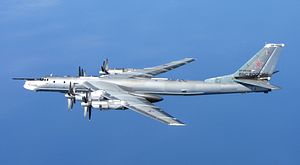The Russian Ministry of Defense (MoD) and Russian aerospace and defense company Tupolev signed a contract for the upgrade of nuclear-capable Tupolev Tu-95MS strategic bombers at the beginning of July, the head of Tupolev, Alexander Konyukhov, told local media this month.
According to Konyukhov, modernization work on the Tu-95SM will be undertaken at the Beriev Aircraft Company, located in Taganrog in southern Russia. The first upgraded Tu-95SM under the recently signed contract, designated Tu-95SMS, is expected to conduct its maiden flight by the end of 2019.
The Russian Air Force operates around 60 Tu-95s including a dozen Tu-95SMS bombers, according to the Russian MoD.
The improved Tu-95MSM variant, like its Soviet-era predecessor, is a four-engine, long-range, turboprop, strategic bomber that can be armed with nuclear stand-off cruise missiles such as the Kh-101/Kh-102 (nuclear variant) air-launched cruise missile as well as the Kh-55 subsonic air-launched cruise missile.
The aircraft can carry six missiles on an internal rotary launcher, while the modernized Tu-95MSM variant can carry an additional eight to ten missiles under its reinforced wings.
The Russian Air Force wants to upgrade a total of 20 Tu-95MS bombers to the MSM variant.
Upgrades will include a new weapons launch system, new avionics and navigation systems, as well as a new engine to increase the operational range of the aircraft. The new Tu-95MSM variant, which conducted its first combat mission in Syria in 2015, features a new target-acquisition system/navigation system based on Russia’s Global Navigation Satellite System (GLONASS).
According to a press release by Russian state-owned corporation Rostec, the new engine will be an upgraded version of the Kuznetsov NK-12 turboprop engine first introduced into service in the 1950s.
“The NK-12MPM engine developed by the Samara-based Kuznetsov public company (part of the UEC [United Engine Corporation] within Rostec) is a modification of the NK-12MP, the world’s most powerful (15,000 hp) serial-produced turbo-prop engine,” the press statement reads.
“It allows improving the aircraft’s take-off characteristics and increasing the load-carrying capacity and the flight range of the missile-carrying bomber. The new powerplant uses more powerful propellers created by Aerosila Research and Production Enterprise while the new design solutions have almost halved the vibration level.”
The Russian MoD has also ordered the upgrade of its fleet 16 of supersonic Tu-160 strategic bombers. As I reported in July:
A new variant, designated Tu-160M2, is expected to enter service in the early 2020s with the first bomber expected to be delivered to the Russian Air Force by the end of this year. (…)
Russian President Vladimir Putin mandated the overhaul of Russia’s Tu-160 force due to delays in the next-generation strategic stealth bomber project, dubbed PAK DA (an acronym for “Prospective Aviation Complex for Long-Range Aviation”) in 2015.
The Tu-160M2 will feature upgraded avionics and a new special coating, according to Russian defense officials, to reduce the plane’s radar signature. Crucially, the bomber will also be fitted with a new engine. However, designing and building a next-generation engine has proven difficult for the Russian aviation industry to date. (…)
Delivery of the first ten upgraded Tu-160M2 strategic bombers is slated to be completed by the end of 2027, according to the Russian MoD.
































